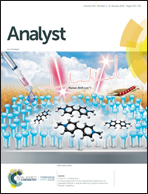A simple colorimetric sensor for the detection of moisture in organic solvents and building materials: applications in rewritable paper and fingerprint imaging†
Abstract
A simple off-the-shelf dye molecule, 1,4-dihydroxy-9,10-anthraquinone or quinizarin (1), has been investigated for the effective detection of moisture in organic solvents and building materials. Anion-induced deprotonation of 1 to 1.F followed by re-protonation with water is the working principle of the sensor system. Changes in colour, UV-Vis spectra and emission intensity indicate the moisture detection of 1.F in various organic solvents. The probe 1.F is more effective at the detection of water in acetonitrile and THF with a LOD of 0.0011 and 0.0026 wt%. Probe 1.F is reversible, reusable, highly selective, and sensitive and has a fast response time both in solution phase and in test papers. Probe 1.F is also applied for the detection of unknown moisture content in raw building materials such as cement, fly ash, foundry sand, and limestone. 1.F incorporated cellulose-based papers are applicable for inkless writing and stamping in the read–erase manner. Furthermore, these papers are also suitable for fingerprint imaging and sweat pore mapping by the simple colour change method.



 Please wait while we load your content...
Please wait while we load your content...